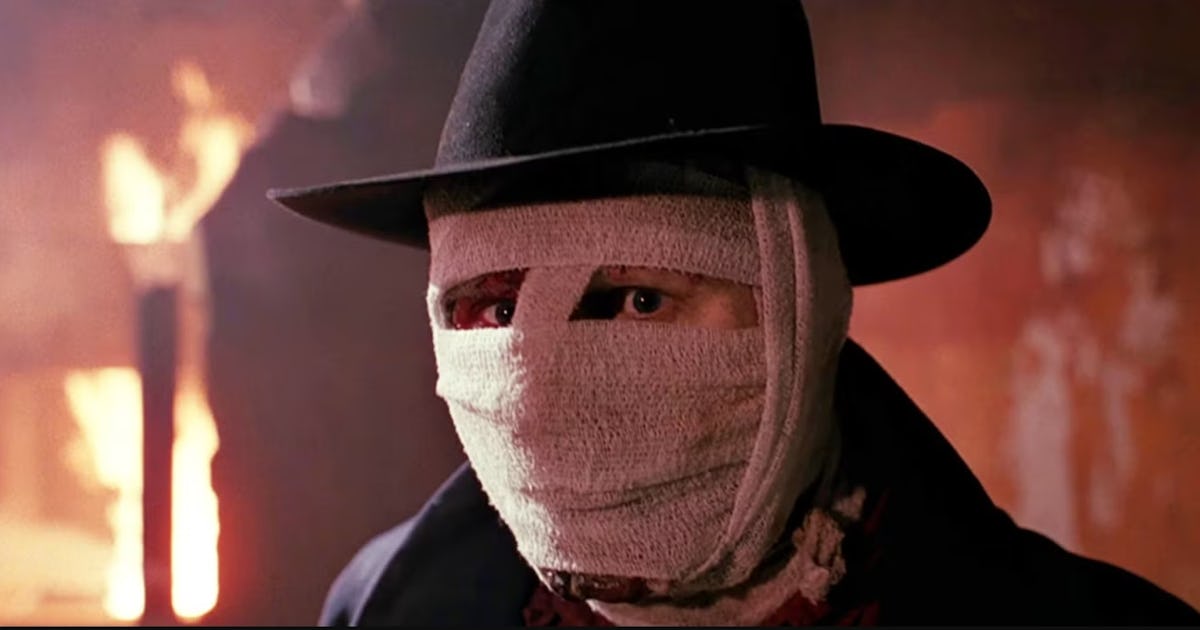In another world, the first comic book movie Sam Raimi directed would’ve been The Shadow. Fresh off the success of The Evil Dead and its sequel, he sought to bring the crime-fighting pulp hero to the big screen, only for Universal Studios to refuse to part with the rights. “I met with them, but they didn’t like my views at all,” he said. The director then revisited a short story he’d written, about a man who could alter his face to impersonate others. Denied a shot at adaptation, Raimi set out to deliver an original.
The result was Darkman, a gripping yet goofy tale of rage, revenge, and a renewed chance at lost love, starring a pre-action hero Liam Neeson as a tortured scientist. Inspired by the Universal horror movies of the ‘30s, Darkman was imbued with the look and feel of a comic book, combining kinetic camerawork with images that burst across the screen. Darkman scored terribly in previews, but was critically well-received and commercially successful, spawning two sequels, albeit without Raimi or Neeson. But its visual flair and characterization would also form the blueprint for the director’s next superhero outing, the Spider-Man trilogy.
Released on this day in 1990, 12 years before Spider-Man, Darkman also serves as a superhero origin story, with much of the same pathos and struggle to reconcile one’s sense of self. Suffering major burns after a lab explosion rigged by a corrupt crime boss (Larry Drake), Dr. Peyton Westlake (Neeson) is taken to a hospital, where, to spare him unbearable pain, doctors subject him to an experimental procedure. The side-effects? Increased strength and uncontrollable rage. A disfigured Peyton escapes, setting up a makeshift lab to continue working on his synthetic skin prototype. Fun stretches of shenanigans contain an underlying ticking-clock tension as the doctor crafts models of the gang members’ faces, poses as them, and frames them for various crimes, all while working with unstable skin that disintegrates after just 99 minutes.
By the end, the sight of Peyton swinging wildly across the city, squeezing through buildings and over traffic, registers as classic Spider-Man imagery — that he’s holding onto a helicopter the bad guys are fleeing in is a minor detail — but the web connecting both films is apparent even early on.
When Peyton awakes at the hospital, overwhelmed by memories of the fire and his experiments, the overlapping imagery mirrors that of Peter Parker’s (Tobey Maguire) post-spider bite dream sequence. Footage from Darkman was used in the Spider-Man montage, and a split-second shot of a skull that invades Peter’s subconscious resembles the one from Darkman. Later, Peyton hunting down the henchman who shot his lab assistant is staged much like Peter stalking his uncle’s murderer in an abandoned warehouse, with both characters visualized as shadows tormenting their jumpy targets before they finally manifest in the flesh.
A sequence of Peter arriving at his suit design through a series of trial-and-error parallels Peyton’s attempts to fine-tune his formula, though the imagery superimposed over both hard-working protagonists tells a different story. While the teen is motivated by what he loves — his neighbor’s blue eyes and red hair ultimately inspire his suit colors — Peyton is dogged by failure, as terse descriptions on his discarded notepad sheets attest to.
Darkman’s action scenes set the stage for Spider-Man’s mainstream success.
Universal Pictures
For all the visual parallels drawn between him and Peter, Peyton also has much in common with the superhero’s Spider-Man 2 antagonist, Dr. Otto Octavius (Alfred Molina), dubbed Doc Ock after four AI-powered mechanical tentacles end up fused to his spine. Both are sensitive scientists who endure not only alienating physical transformations but also the emergence of a darker, more violent emotional streak following an experimental procedure. (Bonus points for the isolated, ramshackle lab setting both men retreat to.) Raimi locates the humanity in these monstrous men as they grapple with who they were and what they’ve become.
Unlike Spider-Man, however, Darkman was unrestrained by the usual PG-13 rating of superhero fare, giving Rami free rein to stage some of the most gonzo executions in the genre’s history. The opening sequence features a henchman whipping off a fake leg that doubles as a shotgun, then decimating a rival gang. Later, a vengeful Peyton props up a henchman in an open manhole, enabling his head to be crushed under a truck’s wheel.
Just as tense is Darkman’s climactic battle, unfolding at a construction site where Peyton must delicately balance atop skyscraper beams while facing off against a much more poised opponent. The choice of climactic battle location recurs in Spider-Man 3, as does the plot point of having the hero’s girlfriend held hostage hundreds of feet above the ground.
The most poignant parallel between Raimi’s two protagonists comes from him ending Darkman and Spider-Man with inner monologues of his heroes embracing their newfound identity, but pushing away the woman they love to keep her safe. Long before, “This is my gift. My curse. Who am I? I’m Spider-Man,” came, “I’m everyone. I’m no one. Everywhere. Nowhere. Call me ‘Darkman.’” Unlike his scarred scientist, Raimi had perfected a formula of his own.
Source link
Movies,Superheroes,Science Fiction,movies,spider-man,superheroes,science-fiction,entertainment,freelance,movie-tv-anniversary,inverse-recommends-movies,homepage,hp-latest,adex-light-bid,freelance-recs



Average Rating